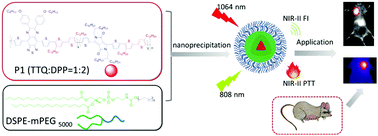Double-acceptor conjugated polymers for NIR-II fluorescence imaging and NIR-II photothermal therapy applications†
Abstract
Single-component nanoplatforms combined with the second near-infrared optical window (NIR-II, 1000–1700 nm) fluorescence imaging (FI) and NIR-II photothermal therapy (PTT) have received increasing attention owing to their capacity for precise diagnosis, noninvasive therapy, and real-time monitoring of the therapeutic effects. However, most of the PTT treatments are performed in the NIR-I window (700–900 nm). Moreover, the design and development of conjugated polymers (P1, P2, and P3) with both bright NIR-II fluorescence and superior NIR-II photothermal effect remained a huge challenge. Therefore, three double-acceptor conjugated polymers were designed and developed by adjusting the molar ratios of two acceptors, TTQ and DPP. Subsequently, their corresponding nanoparticles were fabricated, and finally, nanoparticles based on the conjugated polymer P1 (P1 NPs) with both high NIR-II fluorescence intensity and superior NIR-II photothermal efficiency were selected and applied for NIR-II FI and NIR-II PTT. Importantly, the experiments of in vivo NIR-II FI and NIR-II PTT demonstrated that P1 NPs exhibited not only high accumulation in the tumour sites and high sign-to-background ratio (SBR) of vascular imaging, but also superior NIR-II PTT efficiency for tumour treatment.

- This article is part of the themed collections: 2021 Journal of Materials Chemistry B most popular articles and Journal of Materials Chemistry B Lunar New Year collection 2022


 Please wait while we load your content...
Please wait while we load your content...